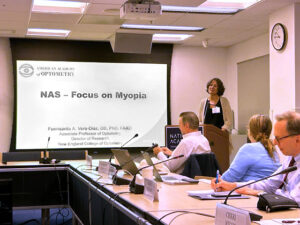August 16, 2023

Dr. Vera-Diaz presented about myopia on behalf of the AAO.
BOSTON, Ma. — The National Academies of Science, Engineering, and Medicine (NASEM) held its first meeting of the Committee on Focus on Myopia in an open session on July 18, 2023. As part of the meeting, Fuensanta A. Vera-Diaz, OD, PhD, FAAO, Director of Research and Associate Professor of Optometry at the New England College of Optometry (NECO), spoke on behalf of the American Academy of Optometry (AAO).
The National Academies Board on Behavioral, Cognitive, and Sensory Sciences formed a committee that will deliver a consensus study on findings, conclusions, and recommendations on myopia. This Board is led by Daniel Weiss of the National Academies. The study committee is co-chaired by Terri Young, Chair of the Department of Ophthalmology and Visual Sciences at the University of Wisconsin-Madison, and Kevin Frick, Professor at Johns Hopkins Carey Business School.
The study process will include five committee meetings over the course of a year. The evidence-gathering phase will include an open session workshop in December 2023 and a review of commissioned papers to provide more information on specific topics. The Committee will then draft a report that will go under review by 12-15 reviewers who will comment and question the report before the National Academies endorsement of official findings and recommendations.
Organizations sponsoring the study participated in the first open session in July to provide an understanding of why they felt myopia was worth further investment, why it is a pressing problem, and what aspects they would like to see addressed thoroughly by the report. Sponsoring organizations include the American Academy of Optometry, the National Eye Institute, the American Optometric Association, the Healthcare Alliance for Patient Safety, Johnson & Johnson Vision, Meta Reality Labs, Research to Prevent Blindness, and the Warby Parker Impact Foundation.
Dr. Vera-Diaz explained why myopia is much more than a refractive error, and she defined myopia as a disease caused by excessive elongation of the eye. Myopia impacts both spatial and temporal visual performance, even when vision is corrected by glasses, contact lenses, or refractive surgery. The high-risk of blinding diseases associated with myopia, even with low levels of myopia, is a key concern.
“We must close the gaps in our knowledge regarding the etiology of myopia and the mechanisms behind the currently available treatments for myopia if we want to improve treatments and prevent myopia altogether, which should be the goal,” Dr. Vera-Diaz said.
Dr. Vera-Diaz further addressed the need for experimental studies to determine the following:
- What aspects of being outdoors are protective against myopia?
- What aspects of near work contribute to myopia?
- Which children will benefit from treatments that slow the progression of myopia? How much will they benefit?
- Why and how do treatments, including spectacles, contact lenses, surgical, pharmacological, and red-light therapy, work at the molecular, cellular, but also the visual level?
- Can current myopia control treatment trial results be extrapolated to other demographics?
- How can we accurately measure the success of myopia control treatments?
The AAO priorities for the NASEM Statement of Task include:
1) To provide independent and objective, biased-free, evidence-based information that clinicians can trust and easily access and interpret.
2) To promote studies that aim to understand the etiology of myopia that will lead to more effective, useful, and accessible programs and treatments to control myopia.
3) To educate clinicians and the public that myopia is a significant public health concern and that action is needed.
These priorities will lead to the AAO’s goal for this study, preventing myopia.
“On behalf of the American Academy of Optometry, we thank Dr. Vera-Diaz for representing our organization and our patients. This is an exciting NASEM initiative designed to address the current mechanistic understanding of myopia pathogenesis, identify knowledge gaps, and develop a research agenda to better understand the biological and environmental factors that cause myopia. We look forward to NASEM’s report,” said Dr. Susan A. Cotter, President, American Academy of Optometry.
The July 18 meeting is available to watch here.













